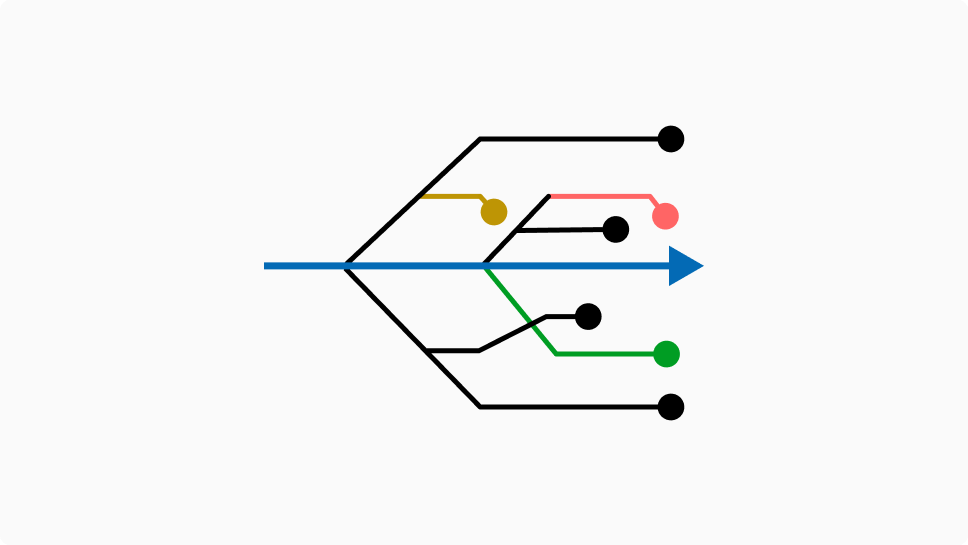Table of Contents
The decisions we make shape our lives.
And the life you are living today is a result of all the choices you made in the past.
This is why decision-making is one of the most important meta-skills that you can learn to radically improve your life, starting today.
🤦♂️ Bad Decision-Making
Think about the state of your life, your career, your business, your major relationships – anything consequential to you.
How many important decisions have you already had to make? And, with the benfit of hindsight, how well did you make them?
I can certainly say for myself that I’ve made lots of bad decisions in my life. Like continuing my path to be a lawyer many months after realising my heart wasn’t in it or the time I spent 6 months avoiding exercise because I thought making money was more important than my health.
And there are 3 broad reasons why I think we often fail to make effective decisions:
- Firstly, we’re unintentionally stupid – Now, I like to think that I’m rational and always make the best decisions, but that’s rarely actually the case. There are loads of situation that make us more prone to stupidity than we like to think. For example, when we’re tired, overly focused on a goal, rushing, distracted, under the influence of a group and stuff like that.
- Second, we like to look good instead of do good – It’s far easier for us to signal being virtuous than actually be virtuous. This means we unconsciously make choices based on optics, politics and defendability so we can avoid criticism from others. In fact, we often want to feel good about ourselves first and have the outcome we desire second.
- Finally, we use the wrong mental models – The quality of our mental models determine the quality of our thinking. And we need to make sure we are continuously updating and improving those mental models over time so we can make the best decisions regardless of the environment we’re in.
Now, of course, not all decisions matter. When the stakes are low, a decision can and should be made quickly. Like, deciding whether you’re going to wear shirt X or shirt Y or eat sandwich X or sandwich Y.
But, some decisions are critical – they change our lives. Whether its who to trust, where to live, or whom to marry, these decisions reverberate for years.
So, I want to share with you the 4 components of effective decision-making:
🤔 Step 1: Define the Problem
This sounds stupidly obvious. But people often end up solving the wrong problem when making decisions and this causes us to waste a lot of time.
The main reason for this, I think, is because it’s far easier to treat the symptoms than find the underlying disease or to put out fires rather than prevent them.
For example, if we’re feeling stressed and overwhelmed our immediate response might be to try and manage this feeling by watching tv or scrolling on social media. But, if we really tried to define the problem, we’d probably realise that stress isn’t actually the issue. Instead, the real problem is our chronic overcommitment to tasks, poor time management, or even being in a job that doesn’t align with our personal values. So, simply finding ways to relax won’t solve the underlying issue.
From all of this, we can pinpoint two key principles to keep in mind:
- First, the definition principle – we need to take responsibility for defining the problem.
- And, second, the root cause principle – we need to identify what’s causing the problem in front of us.
Actually, one handy tool here for identifying the root cause of a problem is to ask yourself ‘what has to be true for this problem not to exist in the first place?’. For example, a lot of dog shelters struggle to get people to adopt, which leads them to ask ‘how can we get more people to adopt?’. But answering that question doesn’t make progress towards the long-term solution.
Because of this, Lori Weise, the founder of Downtown Dog Rescue in LA asked another question instead: ‘what would have to be true for there to be fewer dogs to adopt in the first place?’
And she found 30% of dogs were owner surrenders – pets voluntrily given up by their owners because they couldn’t afford to feed them or care for them. So, she decided to start a new program where staff asked if they’d prefer to keep the pet and receive support from the shelter.
This was cheaper than housing the dog at the shelter and enabled 75% of the families to keep their dog instead of surrendeing it.
🔍 Step 2: Explore Possible Solutions
Once we’re clear on the problem it’s time to think of possible solutions.
One of the common errors at this stage of the decision making process is to resort to magical thinking – putting our head in the sand and hoping the problem will disappear on its own or that a solution will present itself to us. And I get it, dealing with the fact we’re overweight, in an unhappy relationship, and still living in our parents’ basement is super uncomfortable.
But, we need to face up to the reality of what’s in front of us. Which leads me on nicely to 2 more principles:
- The bad outcome principle, and
- The second-level thinking principle.
The bad outcome principle then encourages us to imagine the things that could go wrong and how we’ll overcome them if they do.
It’s about tackling the problem head on. Like, if we have a presentation next week, we can imagine all the ways it could go wrong: what if the technology fails? What if they can’t find the presentation? And what if the audience isn’t engaged? Nothing should be left out of considersation. The truth is most people aren’t actually bad problem solvers, they’re just really bad problem anticipators – if you can anticipate the problems in your weight loss journey or your business plan, you’re going to significantly increase your chances of success.
The second-level thinking principle then gets us to ask ourself ‘and then what?’.
The idea here is that with first level thinking, we’re looking to solve the immediate problem without regard to any future problems that solution might produce. For example, we’ll happily eat a chocolate bar now without thinking of the downstream effects of that. But, second level thinking looks at the problem from beginning to end. It looks past the immediate solution and asks ‘and then what?’. The chocolate bar doesn’t seem quite so tempting when you answer this question.
Actually, Suzy Welch’s 10-10-10 framework is a good one to apply here too. Basically, before you make a decision, ask yourself three questions:
- 10 minutes from now, how will I feel about this decision?
- 10 months from now, how will I feel about this decision?
- 10 years from now, how will I feel about this decision?
It’s easy to feel pretty good about a decision 10 minutes from now, especially if instant gratification or conflict avoidance is involved. But, taking a longer-term perspective gets your future self involved and offers a totally different perspective.
The other thing this prevents is binary thinking.
When we first make a decision, it’s easy to think it’s this or that: we launch a product or we don’t; we take a new job or we don’t; we get married or we don’t. But it’s rarely black and white like this. The best decision-makers know this, and see binary thinking as a sign that we don’t fully understand a problem – that we’re trying to reduce the problem’s dimensions before fully understanding them.
So getting ourselves to think into the future helps us to see the problem from multiple angles.
We can also prevent binary thinking by using the 3+ principle.
Basically, force yourself to explore at least three possible solutions to a problem. Even if we don’t choose the third option, forcing ourselves to develop it helps us understand the problem better. It gives us more opportunities to align our decisions with our goals, offers more optionality in the future, and increases the chances that we’ll be happier with our decision down the road
🤷♂️ Step 3: Evaluate the Options
Now we’ve worked out some potential solutions – each suggesting a course of action that might work – we need to evaluate the options and pick the one most likely to make the future easier.
But, to evaluate the options, we need to know the criteria. And each problem has it’s own specific criteria, which should become apparent when you understand the problem properly.
For example, if I were renovating my house the criteria could be experience of the builders, their availability, and how long it will take to complete the project. Or, if I were deciding on a new diet to improve my health, the criteria might include the nutritional value of the diet, how easy it is to follow, and how well it fits with my lifestyle and dietary preferences.
Once we have our list of criteria, we then need to define which of those things is the most important.
You see, not all criteria are the same. There might be a hundred variables but they are not equally important. So, when we’re clear on what’s important, making the decision becomes so much easier.
For instance, using the diet example, the nutritional value of the food is completely pointless if it isn’t something we’ll stick to long term because it’s impossible to follow or doesn’t fit with our lifestlye. Instead, we’re far more likely to achieve our goal of losing weight by eating less nutritionally perfect food from time to time if it means we’re more likely to maintain a consistent and sustainable eating habit.
So create your criteria, choose which criteria is most important, and evaluate the options based on that thing.
💪 Step 4: Do it
Finally, we need to take action.
Honestly, this can be difficult. And I find that one of the main reasons for this is because making a decision can be scary.
Like, we may be scared of being wrong or scared of the consequences. It’s not so much that we don’t know what to do as much as we don’t want to deal with the reality of doing it. We don’t want to have conversations, because they might hurt people’s feelings. Or we don’t want to fire the person that we like, even though we know they’re wrong for the job.
But, I’ve found that we shouldn’t really be scared of making decisions in most cases, because most decisions in life are type 2 decisions.
Basically, not all decisions are created equal. A type 1 decision is one that’s irreversible and has significant impact in our life, whereas a type 2 decision is one that’s reversible and has far less severe consequences. Almost all our decisions fall into this second category: we can reverse course, change our minds, and mitigate the impact with relative ease.
The reality is that we’re rarely trapped by the decisions we make. If you don’t like your job, you can quit. If you don’t like your new phone, you can return it. If you are unhappy with your relationship, you can leave.
So, if the cost to undo the decision is low, make it as soon as possible. And only delay a decision, if the cost to undo a decision is high.
Either way, it’s actually really hard to be 100% certain about any decision we make. And that’s totally cool. As long as we’re just over 50% sure of a decision, then that’s enough. And 99% of the time it will turn out to be the correct decision anyway. If not, it’s probably not too late to change our mind.

